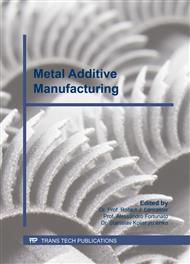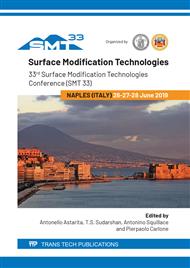[1]
I. Gibson, D. Rosen and B. Stucker, Additive manufacturing technologies: 3D printing, rapid prototyping, and direct digital manufacturing, Springer, (2014).
DOI: 10.1007/978-1-4939-2113-3
Google Scholar
[2]
F. Caiazzo, F. Cardaropoli, V. Alfieri, V. Sergi and L. Cuccaro, Experimental analysis of Selective Laser Melting process for Ti-6Al-4V turbine blade manufacturing, in XIX International Symposium on High-Power Laser Systems and Applications 2012, Istanbul, (2013).
DOI: 10.1117/12.2010577
Google Scholar
[3]
F. Caiazzo, V. Alfieri, G. Corrado and P. Argenio, Laser powder-bed fusion of Inconel 718 to manufacture turbine blades,, The International Journal of Advanced Manufacturing Technology, vol. 93, n. 9-12, pp.4023-4031, (2017).
DOI: 10.1007/s00170-017-0839-3
Google Scholar
[4]
Y. Kaynak and O. Kitay, Porosity, surface quality, microhardness and microstructure of Selective Laser Melted 316L stainless steel resulting from finish machining,, Journal of Manufacturing and Materials Processing, vol. 2, n. 36, (2018).
DOI: 10.3390/jmmp2020036
Google Scholar
[5]
M. Fousova, D. Vojtech, K. Doubrava, M. Daniel and C. Lin, Influence of inherent surface and internal defects on mechanical properties of additively manufactured Ti6al4V alloy: comparison between Selective Laser Melting and Electron Beam Melting,, Materials, vol. 11, n. 537, (2018).
DOI: 10.3390/ma11040537
Google Scholar
[6]
F. Calignano, Investigation of the accuracy and roughness in the laser powder bed fusion process,, Virtual and Physical Prototyping, vol. 13, pp.97-104, (2018).
DOI: 10.1080/17452759.2018.1426368
Google Scholar
[7]
C. Montgomery, C. Farnin, G. Mellos, M. Brand, R. Pacheco e J. Carpenter, Effect of gas shield on surface finish of laser powder bed produced parts,, in 29th Annual International Solid Freeform Fabrication Symposium, (2018).
Google Scholar
[8]
V. Alfieri, P. Argenio, F. Caiazzo and V. Sergi, Reduction of surface roughness by means of laser processing over Additive Manufacturing metal parts,, Materials, vol. 10, n. 30, pp.1-12, (2017).
DOI: 10.3390/ma10010030
Google Scholar
[9]
J. Fox, S. Moylan and B. Lane, Effect of process parameters on the surface roughness of overhanging structures in laser powder bed fusion additive manufacturing,, Procedia CIRP, vol. 45, pp.131-134, (2016).
DOI: 10.1016/j.procir.2016.02.347
Google Scholar
[10]
M. Andani, R. Dehghani, M. Karamooz-Ravari, R. Mirzaeifar and J. Ni, Spatter formation in selective laser melting process using multi-laser technology,, Materials & Design, vol. 131, pp.460-469, (2017).
DOI: 10.1016/j.matdes.2017.06.040
Google Scholar
[11]
F. Calignano, Design optimization of supports for overhanging structures in aluminum and titanium alloys by selective laser melting,, Materials and Design, vol. 64, pp.203-213, (2014).
DOI: 10.1016/j.matdes.2014.07.043
Google Scholar
[12]
International Organization for Standardization, ISO 4287:1997, Geometrical Product Specifications (GPS) - Surface texture: Profile method - Terms, definitions and surface texture parameters, Geneva, (1997).
DOI: 10.3403/30398213u
Google Scholar
[13]
J. Schey, Tribology in metalworking: friction, lubricating and wear, Materials Park: ASM International, (1983).
Google Scholar
[14]
A. Maamoun, Y. Xue, M. Elbestawi and S. Veldhuis, Effect of Selective Laser Melting process parameters on the quality of Al alloy parts: powder characterization, denisty, surface roughness and dimensional accuracy,, Materials, vol. 11, n. 2343, (2018).
DOI: 10.3390/ma11122343
Google Scholar
[15]
P. DePond, G. Guss, S. Ly, N. D. D. Calta, S. Khairallah and M. Matthews, In situ measurements of layer roughness during laser powder bed fusion additive manufacturing using low coherence scanning interferometry,, Materials and Design, vol. 154, pp.347-359, (2018).
DOI: 10.1016/j.matdes.2018.05.050
Google Scholar



